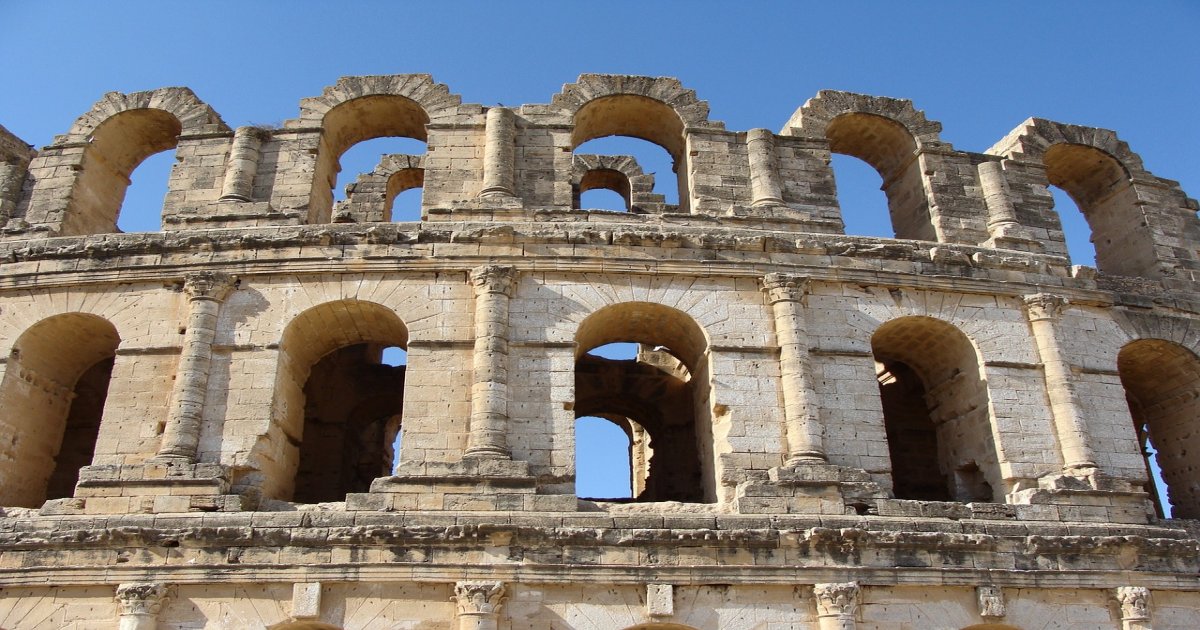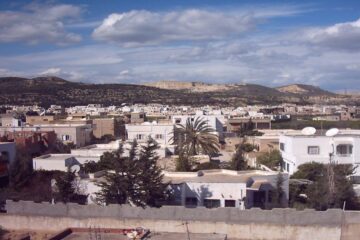The Amphitheatre of El Jem, a World Heritage landmark that has survived the ages, is where we now find ourselves. As you enter this majestic amphitheatre, you’ll feel like you’ve stepped into a time warp to the era of gladiators, chariots, and bloody conflicts.
This historic edifice is one of the world’s biggest and best-preserved Roman amphitheatres, with a capacity of around 35,000 spectators.
The El Jem Amphitheatre, built in the third century AD, was once the focal point of entertainment in Roman Africa. The vast building hosted a wide range of activities, from gladiatorial contests to hunts for exotic animals and even public executions.
Tourists from all over the globe go to the amphitheatre to take in its beautiful architecture and learn about its fascinating past. If you’re interested in learning more about this unique World Heritage site, we invite you to read our article.
History of El Jem Amphitheatre
Let’s go on an adventure through time to learn more about the El Jem Amphitheatre! In the third century A.D., during the reign of the Roman Emperor Gordian, work started on this magnificent building. It took over a decade to finish the building of the new amphitheatre, which was erected on the remains of an earlier one.
The amphitheatre was one of the biggest in the Roman Empire, with seating for up to 35,000 people. Public shows including gladiatorial competitions, animal hunts, and simulated naval warfare made extensive use of this arena.
Despite the fall of the Roman Empire, the amphitheatre continued to be used until the sixth century AD. The El Jem Amphitheatre is a relic of ancient Roman engineering and architecture that has survived earthquakes and looters to endure the test of time.
Architecture and Design of the Amphitheatre

You can’t help but be impressed by this historic building’s clever design and attention to detail. The El Jem Amphitheatre is among the world’s most impressive Roman amphitheatres because of the care and accuracy with which it was constructed.
Some of what sets this amphitheatre apart include the following:
- One of the biggest in the Roman Empire, the amphitheatre could hold up to 35,000 viewers.
- There were three distinct levels of seating: the ima cavea (the lowest level), media cavea (the middle level), and summa cavea (the highest level).
- The amphitheatre’s acoustics were meticulously planned to ensure that every audience member could clearly hear the performance.
- The building’s outside walls are over 40 meters in height and were constructed using a mix of stone and brick.
- The building’s façade displayed the Romans’ creative prowess with elaborate sculptures and friezes.
- Animals and gladiators were brought to the arena through the network of subterranean tunnels and chambers, which added to the spectacle of the games.
El Jem Amphitheatre was built by ancient Romans and is a stunning example of their engineering and architectural prowess. Because of its massive size and elaborate architecture, it remains a popular tourist destination in Tunisia.
El Jem Amphitheatre Tours
Signing up for a tour of the magnificent edifice makes it simple for visitors to learn about the development of Roman entertainment through time. Tour options range from guided excursions conducted by specialists to do-it-yourself audio guides.
The intriguing history of the amphitheatre and its importance in ancient civilization will be revealed regardless of whatever option you choose. Visitors may learn more about the amphitheatre’s history and importance by taking part in a guided tour.
Visitors can find out about the history of the site at their own speed by listening to a recording of a tour guide’s commentary, which is available for self-guided audio tours. No matter whatever tour you pick, don’t forget to soak in the breathtaking scenery and picture what it was like to see a gladiatorial contest or a theatrical production in this massive stadium.
Below are some of the most recommended tours in Tunisia that include a visit to El Jem Amphitheatre:
Where To Stay Near El Jem Amphitheatre
There are several places to stay in the region surrounding the historic edifice for anyone who wants to explore it. In El Jem proper, you’ll find a wide variety of hotels and guesthouses to meet every traveller’s needs and budget. The proximity of some of these establishments to the amphitheatre makes it convenient to visit at any time.
DAR AMMAR is a hotel in El Jem that has a bar, a communal lounge, a restaurant, and free private parking about 250 meters from the Hanchir Zaytoun River. The 4-star hotel has river views from every room and provides visitors with a garden and BBQ grills. All visitors may make use of the hotel’s 24-hour front desk, room service, and exchange of currencies.
You might also consider staying at Mahdia, a beach village around 40 minutes drive from El Jem. There is a greater variety of hotels and resorts to choose from here. Despite its distance from the amphitheatre, Mahdia is a great place to visit if you want to see a different side of Tunisia and enjoy the stunning coastline.
Conclusion
It’s easy to understand why this ancient marvel has grabbed the hearts of so many when you explore the surroundings around it. The El Jem Amphitheatre is a magnificent example of Roman engineering and craftsmanship. People from all over the globe go to see this world heritage site because of its legendary beauty and rich history.
The amphitheatre is an impressive sight because of its size and the fact that so many of its original features have survived to this day. The El Jem Amphitheatre is a must-see for any history lover, architectural fanatic, or someone who enjoys the beauty of a well-preserved relic.
So, what are you waiting for? Start making travel arrangements for this historic marvel right now.
Read also: How many days are enough to see Tunisia?















